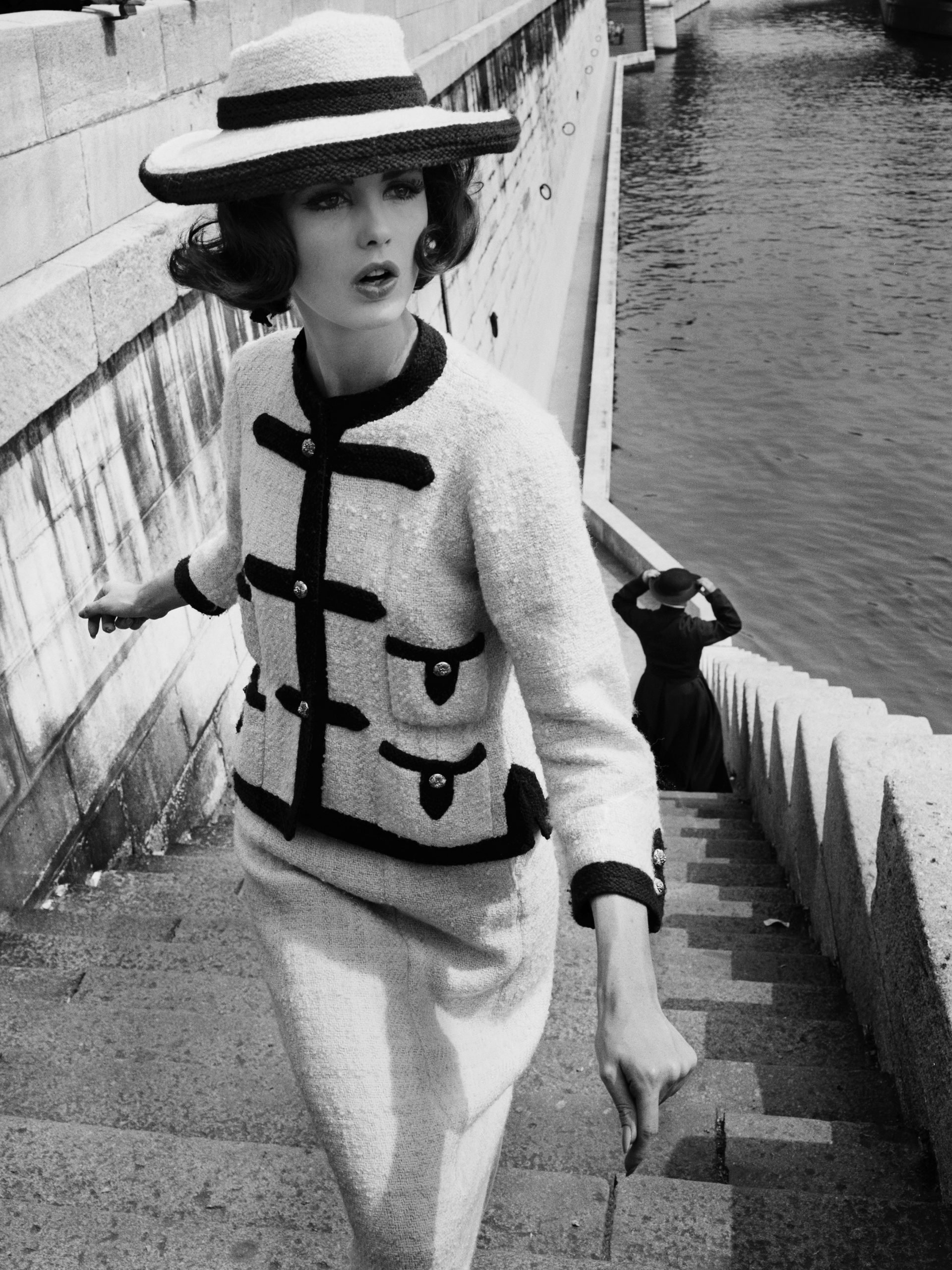
In a new exhibition at the Victoria & Albert Museum in London, Chanel has recreated the famed spiral staircase that its founder, Gabrielle ‘Coco’ Chanel, had in her Paris atelier. That staircase connected the upstairs (her residence) with the downstairs (her showroom), where she staged her seasonal fashion shows. The eagle-eyed couturière would scrutinize the goings-on from her perch on the fifth step from the top, where she had the clearest view of the scene below and could read audience reactions.
Installation view of “Gabrielle Chanel. Fashion Manifesto” at the V&A. © CHANEL.
You can easily imagine Chanel peering down from atop the gleaming staircase at the V&A, too. She’d surely be analyzing and critiquing the garments and accessories milling about on mannequins below. Many of her best-known works are on display, from her celebrated little black dress (LBD) to the classic 2.55 handbag, its braided gold-chain strap freeing scores of women’s hands in the 1920s. A revolutionary idea at the time, the bag was inspired by the key chain dangling from nuns’ waists at the convent where she, an orphan, grew up.
Also on hand in “Gabrielle Chanel. Fashion Manifesto” (through February 25, 2024) are the original costumes she designed for the Ballets Russes production of Le Train Bleu in 1924. Drawn to Sergei Diaghilev’s avant-garde vision of ballet, as well as the impresario’s use of artists Wassily Kandinsky, Alexandre Nikolaevich Benois, and Henri Matisse to create the sets, Chanel similarly defied convention—and constriction—by designing quite sportif ballet costumes.
Ballet dancers Lydia Sokolova, Anton Dolin, Bronislava Nijinska, and Leon Woizikowsky after the first performance of Le Train Bleu in Britain, at the Coliseum Theatre London, 1924, with costumes by Coco Chanel. Photo: © Victoria and Albert Museum, London. © Sasha/courtesy Getty Images
Other pieces on view include one of the earliest known items of Chanel clothing, a marinière blouse dating to 1916; various looks from her 1954 collection, a triumphant return after a 15-year hiatus, at the age of 71; and several outfits created for megawatt stars such as Marlene Dietrich, whom she met in the early 1930s during the filming of Morocco. The two became fast friends.
A marinière blouse of 1916 is the earliest known piece of Chanel clothing. © CHANEL.
In all, the exhibition examines nearly 200 looks, as well as accessories and jewelry. Through 10 themed sections, it explores the complete arc of her most unlikely yet highly intentioned career, from her start as a milliner in 1910 until her final collection in 1971, in which she showed a pair of tailored women’s trousers, to the shock of many. One theme is devoted solely to Chanel’s debut perfume, N°5, a signature of the house and the world’s best-selling fragrance. When Marilyn Monroe said in an interview that she only wears “five drops of Chanel N°5” to bed, the perfume joined the star in becoming an icon—immortalized further when Andy Warhol transferred the square glass bottle to canvas.
Marilyn Monroe applying Chanel N°5. Photo: Ed Feingersh, 1955, New York. © Ed Feingersh/Michael Ochs Archives/Getty Images
“[Chanel’s] contributions to fashion and her radical vision of style created modernity,” said the French luxury brand’s president Bruno Pavlovsky, adding she “was a legend in her own lifetime.” No wonder the V&A jumped at the chance to exhibit the first major show of her work in the U.K. The iconoclastic museum has been priming visitors to think differently about fashion for years, most recently with “Africa Fashion” (2022–2023), “The Art of Menswear” (2022), and “Mary Quant” (2019–2020), and of course Alexander McQueen’s record-breaking “Savage Beauty” in 2015, following its blockbuster debut at the Metropolitan Museum of Art in New York.
Chanel’s tweed suits on display at the V&A. © CHANEL.
The V&A show is based on the exhibition organized by the Palais Galliera in Paris, where, with the support of Chanel, the museum became France’s first fashion museum in 2019. However, the show at the V&A is re-imagined with over 100 new items, including 60 new looks, for its fresh London audience. Surely, those tidy tweed suits—matching jacket and skirt—would not have been possible without Chanel’s adoption of the material by way of a textile factory in Huddersfield. More than 50 tweed ensembles are on display, including a bubblegum-pink set belonging to Lauren Bacall.
Marie-Hélène Arnaud in a tweed suit from Chanel’s Fall/Winter 1959 collection and the 2.55 handbag. © CHANEL
“As one of the most successful fashion houses in existence, Chanel owes much to the templates first laid down by its founder Gabrielle Chanel, over a century ago,” said Tristram Hunt, director of the V&A. “We are delighted to be partnering with Chanel and the Palais Galliera on this exhibition, which provides us with the opportunity to…display little-known historic Chanel garments from the V&A collection.”